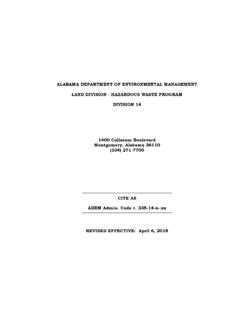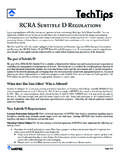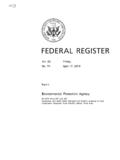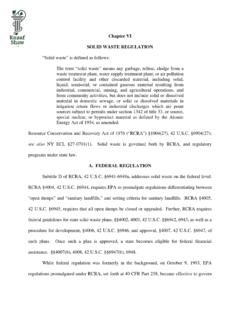Transcription of Management of Remediation Waste Under RCRA - US EPA
1 United StatesEnvironmental ProtectionAgencySolid Waste andEmergency Response(5305W)EPA530-F-98-026 October ofRemediation WasteUnder RCRA printed on paper that contains at least 20 percent postconsumer fiberOctober 14, 1998 MEMORANDUMSUBJECT: Management of Remediation Waste Under RCRATO:RCRA/CERCLA Senior Policy ManagersRegional CounselsFROM:Timothy Fields, Jr., Acting Assistant Administrator forSolid Waste and Emergency Response /signed/Steven A. Herman, Assistant Administrator forEnforcement and Compliance Assurance /signed/Rapid clean up of RCRA corrective action facilities and Superfund sites is one of theAgency s highest priorities. In this context, we often receive questions about Management ofremediation Waste Under the Resource Conservation and Recovery Act (RCRA). To assist you insuccessfully implementing RCRA requirements for Remediation Waste , this memorandumconsolidates existing guidance on the RCRA regulations and policies that most often affectremediation Waste Management .
2 We encourage you to work with the regulations, policies andapproaches outlined in this memorandum to achieve our cleanup goals as quickly and efficiently that not all Remediation wastes are subject to RCRA Subtitle C hazardous wasterequirements. As with any other solid Waste , Remediation wastes are subject to RCRA Subtitle Conly if they are listed or identified hazardous Waste . Environmental media are subject to RCRAS ubtitle C only if they contain listed hazardous Waste , or exhibit a characteristic of hazardouswaste. These distinctions are discussed more completely information in this memo is divided into three categories: information on regulationsand policies that apply to all Remediation Waste ; information on regulations and policies that applyonly to contaminated media; and, information on regulations and policies that apply only tocontaminated debris.
3 Most of the references cited in this memo are available over the Internet. The Federal Register notices published after 1994 are available at ; theguidance memos and other EPA documents are available at Federal Register notices and other documents are also available through the RCRA/CERCLA hotline: in Washington , call (703) 412-9810; outside Washington , call (800) 424-9346;and hearing impaired call (800) 553-7672. The hotline s hours are Monday - Friday, excluding3 Federal holidays, 8:00 - 5:00, eastern standard time. Many EPA guidance memos and otherdocuments may also be obtained through the RCRA/CERCLA hotline fax-back system. Toobtain a list of documents available over the fax-back system, and fax-back system code numbers,call the RCRA/CERCLA hotline at the numbers listed above. I hope this information will assist you as you continue to make protective, inclusive, andefficient cleanup decisions.
4 If you have additional questions or require more information, pleasecontact Robert Hall or Greg Madden, of our staffs, on (703) 308-8484 or (202) and Policies that Apply to All Remediation Wastes Area of Contamination Policy. In what is typically referred to as the area ofcontamination (AOC) policy, EPA interprets RCRA to allow certain discrete areas of generallydispersed contamination to be considered RCRA units (usually landfills). Because an AOC isequated to a RCRA land-based unit, consolidation and in situ treatment of hazardous wastewithin the AOC do not create a new point of hazardous Waste generation for purposes of interpretation allows wastes to be consolidated or treated in situ within an AOC withouttriggering land disposal restrictions or minimum technology requirements. The AOCinterpretation may be applied to any hazardous Remediation Waste (including non-media wastes)that is in or on the land.
5 Note that the AOC policy only covers consolidation and other in situwaste Management techniques carried out within an AOC. For ex situ Waste Management ortransfer of wastes from one area of contamination to another, see discussion of corrective actionmanagement units, below. The AOC policy was first articulated in the National Oil and Hazardous SubstancesPollution Contingency Plan (NCP). See 53 FR 51444 for detailed discussion in proposed NCPpreamble; 55 FR 8758-8760, March 8, 1990 for final NCP preamble discussion. See also, mostrecent EPA guidance, March 13, 1996 EPA memo, Use of the Area of Contamination ConceptDuring RCRA Cleanups. Corrective Action Management Units (CAMUs). The corrective action managementunit rule created a new type of RCRA unit a Corrective Action Management Unit or CAMU --specifically intended for treatment, storage and disposal of hazardous Remediation Waste .
6 Underthe CAMU rule, EPA and authorized states may develop and impose site-specific design,operating, closure and post-closure requirements for CAMUs in lieu of MTRs for land-basedunits. Although there is a strong preference for use of CAMUs to facilitate treatment, Remediation Waste placed in approved CAMUs does not have to meet LDR treatment standards. The main differences between CAMUs and the AOC policy (discussed above) are that,when a CAMU is used, Waste may be treated ex situ and then placed in a CAMU, CAMUs maybe located in uncontaminated areas at a facility, and wastes may be consolidated into CAMU sfrom areas that are not contiguously contaminated. None of these activities are allowed Under theAOC policy, which, as discussed above, covers only consolidation and in situ managementtechniques carried out within an must be approved by EPA or an authorized state and designated in a permit orcorrective action order.
7 In certain circumstances, EPA and states (including states that are notauthorized for the CAMU regulations) may use other mechanisms to approve CAMUs. See, 58FR 8677, February 16, 1993; appropriate use of RCRA Section 7003 orders and comparable stateorders is discussed below and in an EPA guidance memo from J. Winston Porter to EPA RegionalAdministrators, RCRA Permit Requirements for State Superfund Actions, November 16, 1987,OSWER Directive In addition, as appropriate, CAMUs may be approved by EPA asan applicable or relevant and appropriate requirement during a CERCLA cleanup using a recordof decision or by an authorized state during a state cleanup using a CERCLA-like authority and asimilar state document. See, , 58 FR 8679, February 16, 1993. An opportunity for the publicto review and comment on tentative CAMU approvals is required by the regulations whenCAMUs are approved using permitting procedures and as a matter of EPA policy when CAMU sare approved using orders.
8 EPA recommends that, whenever possible, Remediation projectmanagers combine this public participation with other public involvement activities that aretypically part of Remediation . For example, public notice of tentative approval of a CAMU couldbe combined with public notice of a proposed plan Under CERCLA. The CAMU rule is currently subject to litigation; however, the suit has been stayedpending promulgation of the final HWIR-Media regulations. Although EPA proposed towithdraw CAMUs as part of the HWIR-Media proposal, the Agency now intends to retain theCAMU rule. The Agency encourages approval of CAMUs when they are appropriate given thesite-specific conditions. The CAMU regulations are at 40 CFR , promulgated February 16, 1993 (58 FR8658). The differences between CAMUs and AOCs are discussed in more detail in the March 13,1996 EPA guidance memo, Use of the Area of Contamination Concept During RCRAC leanups.
9 Corrective Action Temporary Units (TUs). Temporary units, like corrective actionmanagement units, are RCRA units established specifically for Management of hazardousremediation Waste . The regulations for temporary units (TUs) were promulgated at the same timeas the regulations for corrective action Management units. The CAMU regulations establishedland-based units for treatment, storage and disposal of Remediation Waste ; the TU regulationsestablished non-land based units for treatment and storage of hazardous Remediation Waste . Underthe TU regulations, EPA and authorized states may modify existing MTR design, operating andclosure standards for temporary tank and container units used to treat and store hazardousremediation Waste . Temporary units may operate for one year, with an opportunity for a one yearextension.
10 Like CAMUs, temporary units must be approved by EPA or an authorized state anddesignated in a permit or corrective action order. In certain circumstances, EPA and states(including states that are not authorized for the TU regulations) may use other mechanisms toapprove TUs. See, 58 FR 8677, February 16, 1993; appropriate use of RCRA Section 7003orders and comparable state orders is discussed below and in an EPA guidance memo from Porter to EPA Regional Administrators, RCRA Permit Requirements for StateSuperfund Actions, November 16, 1987, OSWER Directive In addition, asappropriate, TUs may be approved by EPA as an applicable or relevant and appropriate1 Listing determinations are often particularly difficult in the remedial context because the listings are generallyidentified by the sources of the hazardous wastes rather than the concentrations of various hazardous constituents.
















